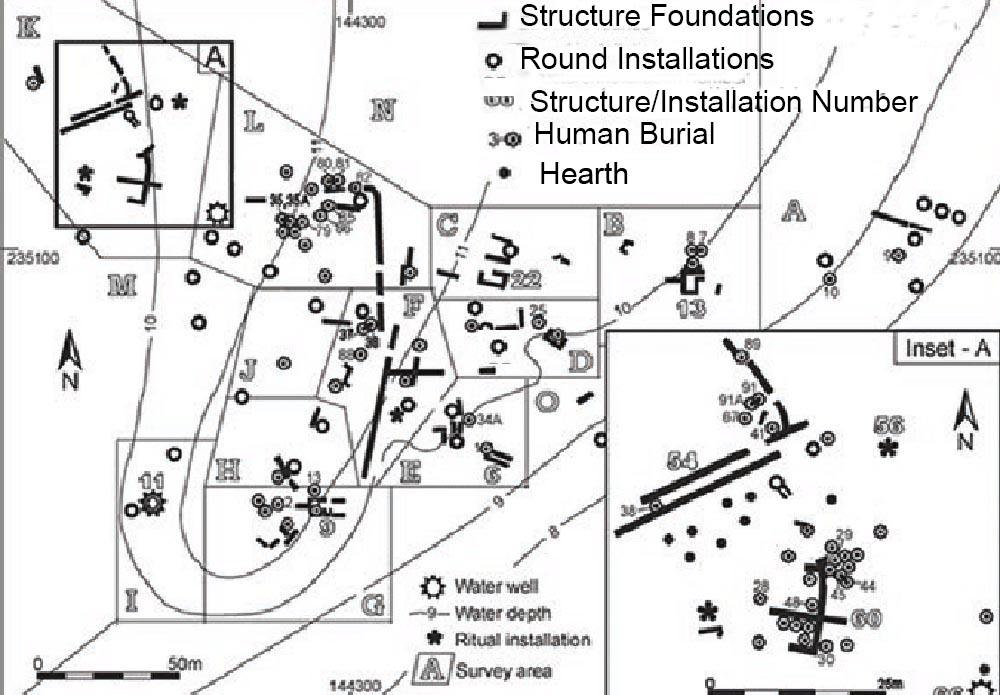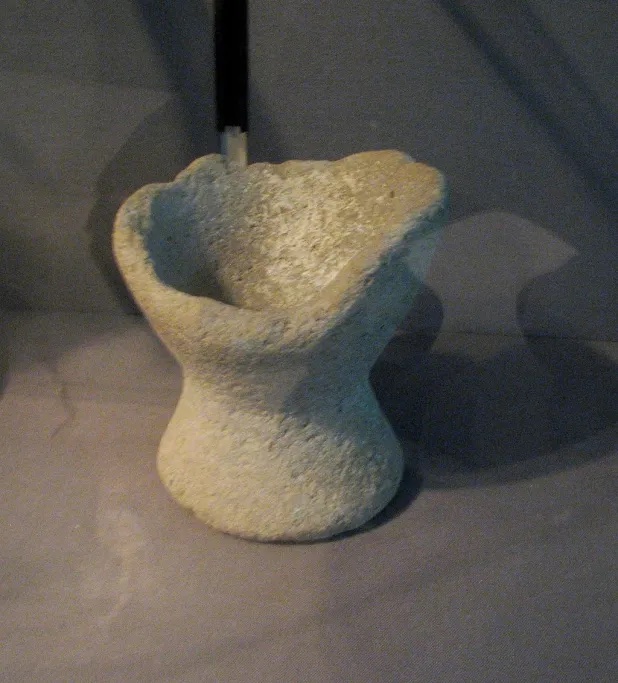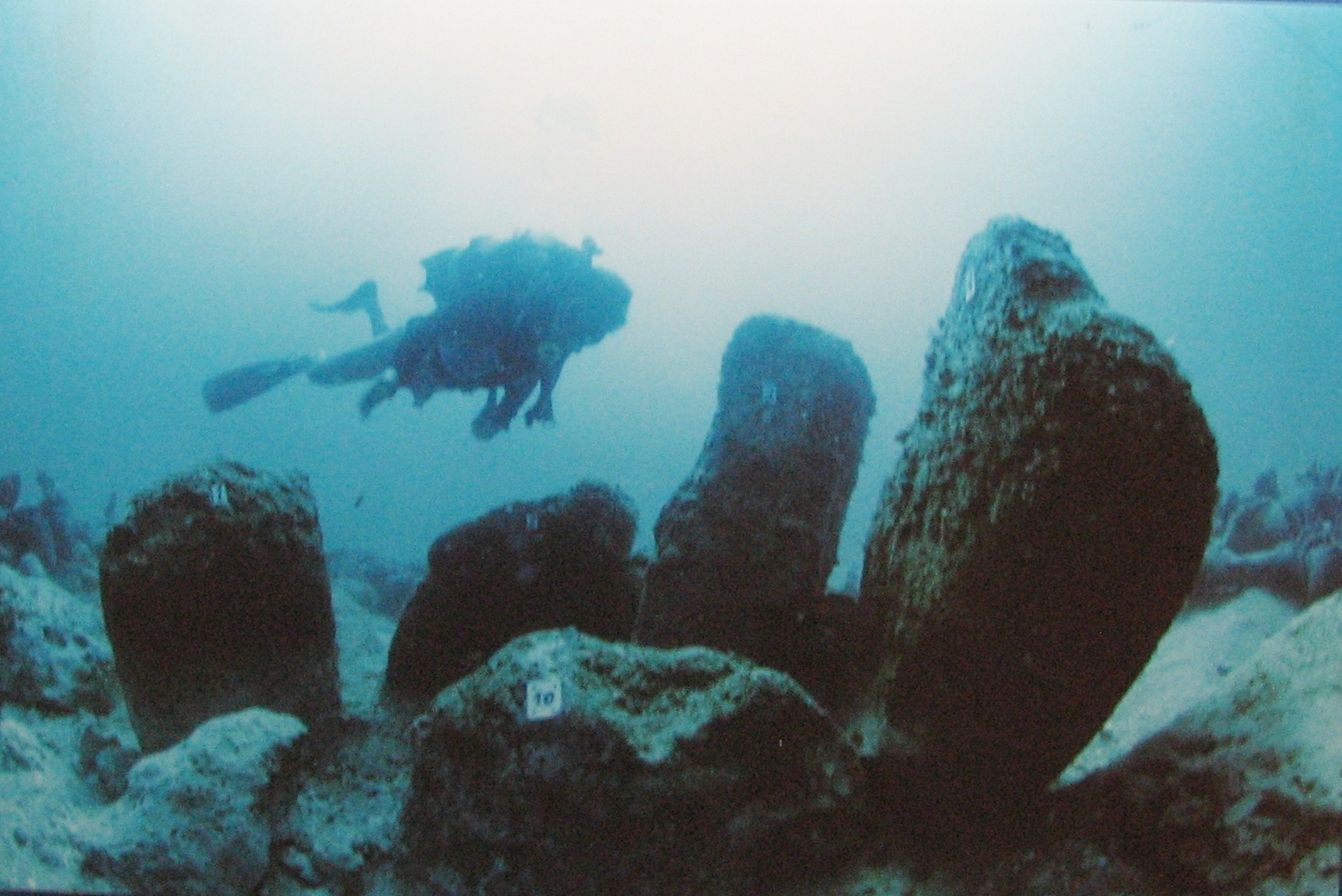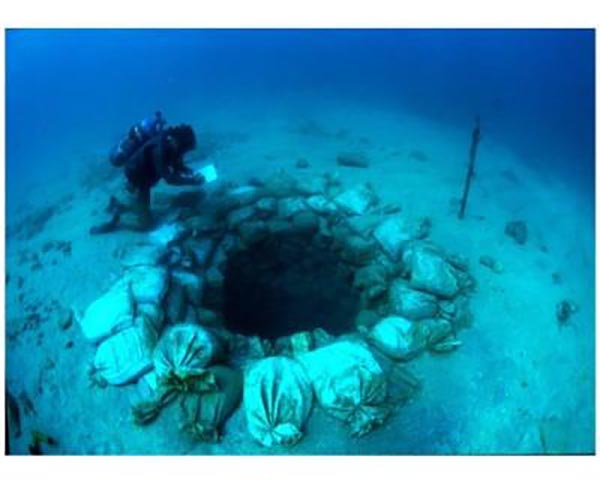

Atlit Yam is an ancient submerged Neolithic village off the coast of Atlit, Israel. It has been carbon-dated as to be between 8,900 and 8,300 years old. Among the features of the 10-acre site is a stone circle.
Atlit-Yam provides the earliest known evidence for an agro-pastoral-marine subsistence system on the Levantine coast.

The site of Atlit Yam has been carbon-dated to be between 8,900 and 8,300 years old (calibrated dates) and belongs to the final Pre-Pottery Neolithic B period. It is currently between 8-12 m (25-40 ft) beneath sea level in the Mediterranean Sea, in the Bay of Atlit, at the mouth of the Oren river on the Carmel coast. It covers an area of ca. 40,000 square meters (10 acres).
Underwater excavations have uncovered rectangular houses and a well. The site was covered by the eustatic rise of sea levels after the end of the last Ice Age. It is assumed that the contemporary coastline was about 1 km (a half-mile) west of the present coast.
Piles of fish ready for trade or storage have led scientists to conclude that the village was abandoned suddenly. An Italian study led by Maria Pareschi of the Italian National Institute of Geophysics and Volcanology in Pisa indicates that a volcanic collapse of the eastern flank of Mount Etna 8,500 years ago would likely have caused a 10-story (40 m or 130 ft) tsunami to engulf some Mediterranean coastal cities within hours. Some scientists point to the apparent abandonment of Atlit Yam around the same time as further evidence that indeed, such a tsunami did occur.

Submerged settlements and shipwrecks have been found on the Carmel coast since 1960, in the wake of large-scale sand quarrying. In 1984, marine archaeologist Ehud Galili spotted ancient remains whilst surveying the area for shipwrecks.
Remains of rectangular houses and hearth-places have been found. Also found was a well that currently lies 10.5 m (35 ft) below sea-level, constructed of dry-stone walling, with a diameter of 1.5 m (5 ft) and a depth of 5.5 m (20 ft) lower.
The fill contained flints, artifacts of ground stone and bone, and animal bones in two separate layers. The upper layer contained partly articulated animal bones, which presumably, were thrown in after the well went out of use.
Other round structures at the site may also be wells. Galili believes that the water in the wells gradually became contaminated with seawater, forcing the inhabitants to abandon their homes.
A stone semicircle, containing seven 600 kg (1,300 lb) megaliths, has been found. The stones have cup marks carved into them and are arranged around a freshwater spring, which suggests that they may have been used for a water ritual.
Ten flexed burials have been discovered, both inside the houses and in their vicinity. The skeletons of a woman and child, found in 2008, have revealed the earliest known cases of tuberculosis. Bone fish-hooks and piles of fish bones ready for trade or storage point to the importance of marine resources.
The men are thought to have dived for seafood, as four skeletons with ear damage have been found, probably caused by diving in cold water.
Anthropomorphic stone stelae have been found. The lithics include arrowheads, sickle-blades, and axes.
An excavation was mounted by the University of Haifa on October 1, 1987. A complete human burial, in an excellent state of preservation, was discovered under 10m of water on October 4 with the skeleton oriented in a flexed position and laid on her right side. Subsequent carbon dating of plant material recovered from the burial placed the age of the site at 8000 +-200 years.
Animal bones and plant remains also have been preserved. Animal bones come mainly from wild species. The plant remains include wild grape, poppy, and caraway seeds. Granary weevils indicate the presence of stored grain. Pollen analysis and the remains of marsh plants indicates the local presence of swamps.
AtlitYam1.jpg

The Atlit Yam sits submerged 10 meters (33 feet) beneath the sea off the coast of Atlit village in Haifa, Israel. An enormous Neolithic coastal settlement, these complex remains tell a story of a once-thriving community that existed almost 9,000 years ago – and this one really did exist.
During the beginning of the Holocene, the Atlit Yam community was believed to have settled at the site over 8,000 years ago. Despite now being completely submerged, at the time of settlement the site sat well above current sea levels, boasting highly fertile land primed for agriculture.
Discovered by marine archaeologist Dr. Ehud Galili in 1984, the site has since been excavated to reveal a glimpse into the lives of the people that once lived there.
Within the large 40,000-square-meter (430,556-square-foot) site, marine archaeologists have found houses, wells, and even graves. Along with the bones of domesticated sheep, pigs, and dogs, large rectangular stone structures still standing beneath the waves are believed to have been used as animal pens, or as fencing to divide cultivated fields.
As many as 65 human skeletons have been found in and around the area, the majority housed in single graves with some remains still relatively intact. The remains of a mother and child were also found at the site, which have revealed the earliest known cases of tuberculosis. Fragments of human bones were also found, along with animals remains and stone tools at the bottom of a 5.5-meter (18-foot) well dug by the villagers.
The monoliths seen in the center of the village are believed to make up a water shrine.
At the center of the settlement sit seven large stone monoliths circling a freshwater spring. It’s believed this structure functioned as a site for conducting water rituals.
Arrowheads, sickle blades, spearheads, and knives were all excavated from the area, as well as large concentrations of flint. One flint collection was found to be comprised of as many as 8,755 flint artefacts. Interestingly, the specific material found at the site appeared to originate from over 10 kilometers (6.2 miles) away in Mount Carmel.
Appearing to be occupied just briefly, there has been speculation as to why the area was abandoned. Some suggest the rising sea levels may have led to the abandonment of the village, while other theories point to the effects of a tsunami.
The tsunami theory is supported by what appears to be the abandoned remains of large piles of fish at the site. These valuable commodities wouldn’t have been purposefully abandoned, so their existence suggests a much harsher fate may have befallen the village.
The region surrounding Israel’s Carmel Coast is home to 17 submerged prehistoric sites, spanning the Pre-Pottery Neolithic period of Atlit Yam, to Pottery Neolithic sites dating back to between 8,000 and 6,500 years ago. Excavation of the area by marine archaeologists began in 1960, and since then the rich heritage of the land beneath the sea has continued to enrich our knowledge of Neolithic settlement life.